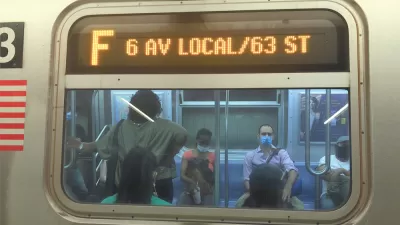More evidence of the essential benefits of public transit, but this time the source of the evidence is found in rural communities all over the United States, like Hugo, Oklahoma.
Aaron Gordon reports on the importance of public transit in rural settings, exemplified in the article by Little Dixie Transit in the small southeastern Oklahoma town of Hugo, which has a budget of $2 million in 2018.
The personal experiences of rural transit differentiate it from the massive public transit agencies in large cities and regions, but rural transit agencies have also been providing essential mobility services during the pandemic.
The coronavirus crisis has had a powerful revealing effect on all aspects of American life. Most poignantly, it has shown us what is essential to our health and well-being. In big cities, public transportation systems that get essential workers where they need to go have received deserved recognition for their critical role in managing the crisis.
But the transit agencies across the country that serve rural populations have been less recognized. In large part, this is because many people don’t even know there’s such a thing as a rural transit agency. When most people think of public transit they think of trains and buses in dense urban areas. And when they think of rural areas, they picture people in cars driving everywhere.
The article includes more insight from other rural transit agencies, as well as insight into the scope of rural transit agencies in the aggregate around the United States. The common thread is clear between all of these rural transit agencies: their work is underappreciated relative to the benefits they deliver to riders.
FULL STORY: Rural Transit Agencies Are Keeping People Alive

Planetizen Federal Action Tracker
A weekly monitor of how Trump’s orders and actions are impacting planners and planning in America.

Restaurant Patios Were a Pandemic Win — Why Were They so Hard to Keep?
Social distancing requirements and changes in travel patterns prompted cities to pilot new uses for street and sidewalk space. Then it got complicated.

Map: Where Senate Republicans Want to Sell Your Public Lands
For public land advocates, the Senate Republicans’ proposal to sell millions of acres of public land in the West is “the biggest fight of their careers.”

Maui's Vacation Rental Debate Turns Ugly
Verbal attacks, misinformation campaigns and fistfights plague a high-stakes debate to convert thousands of vacation rentals into long-term housing.

San Francisco Suspends Traffic Calming Amidst Record Deaths
Citing “a challenging fiscal landscape,” the city will cease the program on the heels of 42 traffic deaths, including 24 pedestrians.

California Homeless Arrests, Citations Spike After Ruling
An investigation reveals that anti-homeless actions increased up to 500% after Grants Pass v. Johnson — even in cities claiming no policy change.
Urban Design for Planners 1: Software Tools
This six-course series explores essential urban design concepts using open source software and equips planners with the tools they need to participate fully in the urban design process.
Planning for Universal Design
Learn the tools for implementing Universal Design in planning regulations.
Heyer Gruel & Associates PA
JM Goldson LLC
Custer County Colorado
City of Camden Redevelopment Agency
City of Astoria
Transportation Research & Education Center (TREC) at Portland State University
Camden Redevelopment Agency
City of Claremont
Municipality of Princeton (NJ)





























